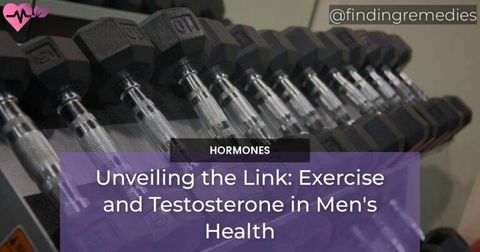Testosterone is a hormone found in both men and women, but it is more commonly known as a male hormone. Testosterone is important for men because it plays a vital role in the development of their sexual characteristics, such as the growth of facial hair, deepening of the voice, and muscle mass development. Exercise and Testosterone go together.
However, testosterone is also important for overall health, as it contributes to maintaining bone density, enhancing mood, and boosting energy levels. Physical exercise can play a significant role in regulating testosterone levels in men, leading to many health benefits.
In this article, we will explore the relationship between exercise and testosterone levels in men, and how physical activity impacts male hormones.
Table of Contents
What is Testosterone and Why is it Important?
Testosterone is a steroid hormone that is produced primarily in the testicles of men. However, it is also produced in women’s ovaries in smaller quantities. Testosterone plays an essential role in the development of male sexual characteristics, regulation of bone density, and muscle mass development. Additionally, testosterone levels can affect mood, energy levels, and overall well-being in men.
How Exercise Affects Testosterone Levels
Physical exercise affects testosterone levels through several mechanisms. One of the primary ways that exercise can increase testosterone levels is by reducing the amount of body fat. Excess body fat can lead to an increase in estrogen levels, which can have a negative impact on testosterone production. Resistance training, such as weightlifting, can also help to increase testosterone levels by promoting muscle growth and development. Additionally, cardiovascular exercise can help to improve blood flow and oxygenation, which can further support healthy testosterone production and hormonal balance.
The type of exercise and its duration and intensity can also have an impact on testosterone levels. High-intensity interval training (HIIT) has been shown to be particularly effective for increasing testosterone levels in men. Resistance training that focuses on compound movements, such as squats and deadlifts, can also be beneficial for boosting testosterone levels.
The Relationship Between Exercise and Testosterone
The relationship between exercise and testosterone levels is complex. While exercise can have many positive effects on testosterone levels, a lack of exercise can have the opposite effect. Men who lead sedentary lifestyles are more likely to have lower testosterone levels than men who exercise regularly. This is because regular exercise can help to maintain hormonal balance and healthy hormone production.
Additionally, over-exercising or engaging in too much cardiovascular exercise can have a negative impact on testosterone levels. This is because excessive exercise can lead to hormonal fluctuations that can negatively impact testosterone production.
ALSO READ
Tips for Increasing Testosterone Levels with Exercise
Specific exercises to increase testosterone levels
- Resistance training: Weightlifting and strength training exercises can promote muscle growth and development, leading to increased testosterone production.
- Interval training: High-intensity interval training (HIIT) has been shown to be particularly effective at increasing testosterone levels in men.
- Aerobic exercise: Cardiovascular exercise can help to improve blood flow and oxygenation, which can support healthy testosterone production.
Recommended frequency and intensity for exercise to boost testosterone
The recommended frequency and intensity of exercise for boosting testosterone levels will vary depending on the individual’s fitness level and goals. However, a general guideline is to engage in resistance training two to three times per week and to include cardiovascular exercise in your fitness regimen.
Diet and lifestyle changes to support testosterone production
- Eat a balanced diet: Consuming a diet that is rich in protein, healthy fats, and complex carbohydrates can help to support healthy testosterone production.
- Get enough sleep: Aim for at least seven to eight hours of sleep per night to support healthy hormone production.
- Reduce stress: Stress can lead to hormonal imbalances and negatively impact testosterone production. Engage in stress-reducing activities such as meditation, yoga, or deep breathing exercises.
Conclusion
In conclusion, testosterone is an essential hormone for men that plays a vital role in their overall health and well-being. Regular exercise can help to maintain healthy testosterone levels, leading to many health benefits. Resistance training, cardiovascular exercise, and high-intensity interval training are all effective ways to boost testosterone levels naturally. By incorporating regular exercise and healthy lifestyle habits, men can support healthy testosterone production and maintain optimal hormonal health.
Frequently Asked Questions
What are the symptoms of low testosterone levels?
The symptoms of low testosterone levels may include decreased libido, reduced muscle mass, fatigue, mood changes, and decreased bone density.
Can high-intensity interval training (HIIT) boost testosterone levels?
Yes, HIIT has been shown to be an effective way to increase testosterone levels in men.
Can too much exercise decrease testosterone levels?
Yes, over-exercising or engaging in too much cardiovascular exercise can lead to hormonal fluctuations that can negatively impact testosterone production.
What foods should I eat to support testosterone production?
Eating a balanced diet that includes protein, healthy fats, and complex carbohydrates can help to support healthy testosterone production. Additionally, consuming foods that are rich in zinc, such as oysters, can also support healthy testosterone levels.
Additional Resources
- Exercise and Testosterone Levels
- Testosterone Revolution by Jay Campbell
- Men’s Health: How to Boost Testosterone Levels
RELATED ARTICLES:

